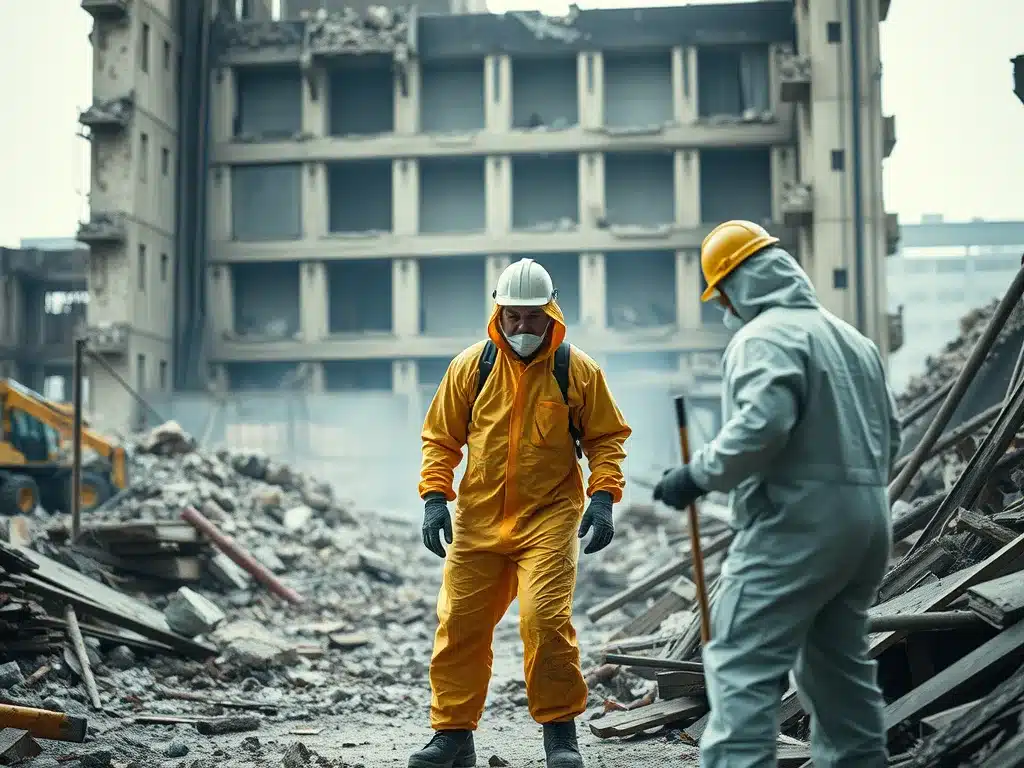Introduction to Demolition
Demolition is a critical process in construction and urban development, serving as the stepping stone for new projects and advancements. The removal of existing structures allows for the reuse of land. It ensures the safety of the inhabitants and enhances community aesthetics and functionality. A structure may need to be demolished for various reasons. These include building age, structural instability, changing regulations, or the need for modern developments. The decision to demolish is often made to create space for new initiatives. This approach ensures that urban landscapes evolve to meet contemporary needs.
Different methods of demolition are employed based on the design and materials of the structure. These methods also consider the surrounding environment. Mechanical demolition is one of the most common approaches. It involves using heavy machinery to dismantle structures efficiently. These machines include excavators and bulldozers. This method is often favored for its effectiveness and speed, particularly in urban settings where space is limited.
In contrast, explosive demolition utilizes controlled explosives to bring down buildings rapidly. It often leaves debris in a manageable state. This technique is usually reserved for large structures or when there is a need to maintain control over surrounding areas. Another approach, called deconstruction, focuses on the careful dismantling of a structure. This process preserves materials that can be reused or recycled. This method is particularly beneficial for sustainability. It minimizes waste. It paves the way for new construction in an environmentally responsible manner.
In essence, the demolition process, with its various techniques, plays a vital role in urban redevelopment. Understanding the factors influencing demolition decisions helps create a more informed perspective on urban planning. It also contributes to insights into the construction industry as a whole.
The Risks of Asbestos in Demolition
Asbestos is a naturally occurring mineral. It was widely utilized in construction materials due to its impressive insulating properties. It also provides resistance to fire. However, industries now approach demolition with more caution because of the health risks associated with asbestos exposure. This caution is especially important when dealing with older buildings. The dangers of asbestos become increasingly relevant during demolition processes, where pre-existing materials may still contain this hazardous substance.
When buildings containing asbestos are demolished, the material can easily break down, releasing microscopic fibers into the air. These asbestos fibers are not visible to the naked eye. Inhaling these particles can result in severe long-term health conditions. Workers directly involved in demolition activities face a heightened risk of exposure. They may inadvertently disturb asbestos-containing materials. This can lead to the inhalation of harmful fibers. As a result, many countries have established stringent regulations to manage and mitigate these risks during demolition efforts.
The general public also faces potential dangers during such operations. Asbestos fibers can disperse into the surrounding environment if appropriate precautions are not implemented. This exposure puts nearby residents and workers at risk of inhaling harmful particulates. Asbestos exposure has been linked to serious diseases such as asbestosis, lung cancer, and mesothelioma. This connection emphasizes the critical need for proper safety protocols. Before starting demolition projects, conduct thorough inspections to identify the presence of asbestos. This allows for the development of effective management plans to minimize exposure. These precautions ensure that both workers and the public are safeguarded.
In light of these risks, implementing best practices in demolition is paramount. Professionals in the field must receive adequate training in asbestos identification and removal procedures. This promotes safety and ensures compliance with prevailing regulations.
Regulatory Standards for Asbestos Removal
The process of asbestos removal is strictly regulated due to the significant health risks associated with asbestos exposure. Regulatory bodies, such as the Environmental Protection Agency (EPA) and the Occupational Safety and Health Administration (OSHA), have established guidelines. These guidelines must be adhered to during demolition projects involving asbestos-containing materials (ACMs). These regulations aim to reduce risks to the public. They also protect workers who might come into contact with asbestos fibers.
Under EPA regulations, any renovation or demolition project involving materials known or presumed to contain asbestos must be reported. An asbestos inspection must be conducted before any work begins. Once ACMs are identified, they must be handled according to the EPA’s National Emission Standards for Hazardous Air Pollutants (NESHAP). These standards lay out specific procedures for the safe removal of asbestos. They also guide the handling and disposal of asbestos to prevent airborne contamination.
OSHA further complements these regulations by enforcing workplace safety standards specific to asbestos exposure. Employers must supply a safe working environment. This includes conducting air monitoring tests. They should provide adequate training on asbestos safety. Employers must also ensure that employees have access to personal protective equipment (PPE). Additionally, OSHA guidelines stipulate permissible exposure limits (PELs) for asbestos. These limits specify the maximum concentration of airborne asbestos fibers permitted. Workers can be exposed to these fibers over a specific time frame.
Compliance with these regulatory standards is essential for any construction or demolition project involving asbestos. Failure to adhere to these laws can result in significant legal repercussions, including fines, work stoppages, and health risks. As such, contractors and property owners must fully understand all relevant guidelines. They should implement these guidelines to ensure a safe and compliant demolition process. This process should prioritize both worker safety and public health.
Identifying Asbestos in Buildings
Identifying materials that may contain asbestos in buildings is a critical step in ensuring safety during renovation or demolition projects. Asbestos is a naturally occurring mineral. It was widely used in construction materials because of its desirable properties. These include heat resistance and durability. However, its inhalation poses serious health risks, which makes the identification of asbestos-containing materials (ACMs) essential.
Common ACMs commonly encountered in older buildings include insulation materials, floor tiles, ceiling tiles, and cement products. For instance, asbestos was often incorporated into thermal insulation products used on pipes and boilers. Additionally, textured coatings and certain types of roofing materials may also contain asbestos fibers. Recognizing these potential hazards is vital. This is especially important in structures built before the 1980s. Regulations limiting the use of asbestos were implemented during that time.
When assessing older structures, it is important to consider several factors. First, one should examine the year of construction, as buildings constructed prior to the ban on asbestos often contain ACMs. Secondly, a visual inspection can help identify suspicious materials. Materials that appear brittle or damaged increase the risk of fiber release. However, visual inspections alone may not provide conclusive evidence of asbestos presence.
Asbestos materials pose potential health risks when disturbed. Therefore, it is advisable to engage professional assessors. They are trained and equipped to conduct thorough inspections. Professionals typically employ various techniques, including bulk sampling and laboratory testing, to determine the presence of asbestos. Proper identification ensures compliance with safety regulations. The assessment also protects the health and safety of occupants and workers.
The Asbestos Removal Process
The removal of asbestos must precede any demolition project. It is a critical step due to the potential hazards it poses to human health and the environment. The process begins with careful planning. This planning involves conducting a thorough inspection of the site. The goal is to identify any asbestos-containing materials (ACMs). This initial assessment helps to develop a comprehensive removal strategy tailored to the specific needs of the project.
Following the assessment, it is essential to ensure that all personnel involved in the asbestos removal process undergo specialized training. This training provides workers with the knowledge and skills to handle ACMs safely. They learn to do this effectively while adhering to regulatory standards. Workers must be familiar with the various types of asbestos. They should understand the health risks associated with exposure. Additionally, they must know the correct use of personal protective equipment (PPE).
Once the planning and training phases are complete, the next step involves establishing containment procedures. This includes sealing off the work area to prevent the escape of asbestos fibers into the surrounding environment. Temporary barriers, such as plastic sheeting, are typically used to create a controlled zone. Additionally, negative air pressure units may be employed to ensure that any airborne particulates are contained within the work area.
During the actual removal process, specialized equipment is utilized to safely extract the asbestos materials. Wet removal techniques are commonly employed to minimize the release of fibers. Workers thoroughly wet the materials before removal, reducing dust generation. Proper disposal procedures are crucial. Asbestos waste must be transported and disposed of at designated hazardous waste facilities. This is essential to mitigate any risks associated with its handling.
In conclusion, the asbestos removal process is a meticulous undertaking that prioritizes safety and compliance with environmental regulations. Risks associated with asbestos can be managed effectively through careful planning. Extensive employee training and strict containment practices play a crucial role. The use of specialized equipment also ensures a safe environment for everyone in the demolition project.
The Role of Professional Asbestos Abatement Contractors
Asbestos abatement is a critical process that requires the expertise of licensed professionals. Engaging a qualified asbestos abatement contractor is crucial. They ensure the safe removal of this hazardous material from buildings before demolition or renovation. These contractors possess specialized training and certifications. This equips them with the knowledge necessary to handle asbestos safely. As a result, they minimize health risks to both workers and occupants of the site.
Professional asbestos abatement contractors must undergo rigorous training. This training includes understanding the properties of asbestos. It also involves identifying its presence in various materials. Contractors need to be aware of applicable regulations governing its removal. They should have the necessary licenses. They must also possess certifications. These can be granted by the Environmental Protection Agency (EPA) or local regulatory authorities. These credentials attest to their expertise. They ensure that contractors are updated on the latest health and safety protocols surrounding asbestos handling.
The services provided by these professionals extend beyond mere removal. Asbestos abatement contractors conduct thorough inspections and testing to determine the extent of asbestos contamination within a structure. Following this, they are responsible for developing and implementing an abatement plan that adheres to both local and federal regulations. This plan often involves the removal of asbestos waste. It also includes the safe disposal of asbestos waste in designated hazardous waste facilities. This ensures compliance with environmental standards.
Furthermore, licensed contractors play a crucial role in maintaining safety on the job site. They are trained to use appropriate protective equipment. They implement measures to control airborne asbestos fibers. These fibers pose serious health risks. Hiring a professional asbestos abatement contractor ensures efficiency. It also guarantees compliance with legal requirements. This significantly reduces the potential for harmful exposure to asbestos during demolition projects.
Waste Disposal and Management of Asbestos-Containing Materials
The removal of asbestos-containing materials (ACMs) requires careful consideration of waste disposal. Management protocols ensure safety. They also ensure compliance with environmental regulations. After the successful removal of asbestos from a site, the resulting waste must be treated as hazardous material. It demands meticulous handling and disposal procedures. This entails following local, state, and federal guidelines to minimize potential health risks and environmental impact.
First and foremost, any asbestos waste generated during the removal process must be securely contained. This can involve utilizing leak-tight containers or double-bagging the materials in appropriately labeled plastic bags. Proper labeling is crucial; it should clearly indicate that the contents are hazardous and contain asbestos. This measure helps to alert workers and waste management personnel of the potential dangers. It ensures that the material is handled with the appropriate safety measures in place.
Transportation of asbestos waste also requires strict adherence to regulatory standards. The transport must be conducted by licensed haulers authorized to deal with hazardous waste. These professionals are trained in the safe transport of asbestos. They know any specific requirements in the jurisdictions they operate within. Additionally, it is imperative that all documentation regarding the transport, possession, and disposal of asbestos waste is accurately maintained.
Once transported, asbestos waste must be disposed of at licensed facilities specifically equipped to handle such materials. These facilities are designed to comply with environmental protections to minimize contamination risks. Some jurisdictions offer designated landfills for asbestos disposal, which are monitored and regulated to ensure safe practices. In contrast, unregulated disposal can lead to significant health hazards and legal consequences.
In essence, the proper disposal and management of asbestos-containing materials are vital to public health. They are also crucial for environmental safety. This necessitates rigorous compliance with established protocols.
Health and Safety Measures During and After Demolition
Demolition projects inherently pose various health and safety risks, particularly when hazardous materials like asbestos are involved. Therefore, implementing effective health and safety measures is crucial to safeguard workers and surrounding communities. One of the most critical aspects during demolition is the utilization of personal protective equipment (PPE). Workers should wear protective gear, including respirators, gloves, and coveralls, to minimize exposure to harmful substances.
Air quality monitoring is another essential component during the demolition process. The use of air monitoring devices can help determine the presence and levels of asbestos fibers or other airborne pollutants. These tools should be employed regularly throughout the demolition to ensure compliance with safety standards. If air quality measurements exceed permissible limits, take immediate action to mitigate risks. This includes halting work until an appropriate response plan is developed.
Additionally, proper training for workers on recognizing asbestos-containing materials and understanding safety protocols is vital. Workers should be trained in safe handling procedures, emergency response, and the identification of potential hazards. Conducting regular safety briefings and site inspections can reinforce these measures and ensure that all safety protocols are followed diligently.
Once demolition is complete, a thorough post-demolition assessment is necessary to evaluate the site for any remaining hazards. This assessment should include visual inspections. It should also involve air quality tests and soil sampling. These processes confirm that no asbestos or other contaminants remain. Such contaminants could affect the future use of the location. Any identified risks should be professionally remedied before allowing access to the site for future development or occupancy. Only after meeting all health and safety standards can the site be deemed safe for its intended purpose.
Conclusion and Importance of Safe Demolition Practices
In the context of demolition projects, the removal of hazardous materials such as asbestos is paramount. Asbestos poses significant health risks, including lung disease and cancer. Its presence in older buildings requires careful planning. Execution during the demolition process is also necessary. Proper asbestos removal is crucial. It protects workers involved in the demolition. It also safeguards the surrounding community.
During any demolition project, the safety of all individuals involved should be the top priority. Adhering to established safety regulations and guidelines ensures that the risks associated with asbestos exposure are minimized. This includes thorough inspections prior to demolition, proper containment procedures during removal, and comprehensive cleanup protocols. Following regulations set by the Environmental Protection Agency (EPA) is crucial. Adhering to standards by the Occupational Safety and Health Administration (OSHA) is also essential. These measures safeguard health and maintain environmental integrity.
Furthermore, engaging professionals who specialize in asbestos abatement can greatly enhance the safety and efficiency of the demolition process. Trained experts possess the knowledge and skills necessary to identify asbestos materials and implement effective removal strategies. Their involvement not only mitigates health hazards. It also ensures compliance with relevant legal frameworks. This prevents costly fines and delays.
In conclusion, the intersection of demolition and asbestos removal highlights the critical need for safe practices within this industry. By prioritizing safety, adhering to regulations, and employing skilled professionals, the associated risks can be significantly reduced. This not only protects the workforce. It also fosters a healthier environment for the community at large. This process underscores the essential nature of responsible demolition practices.



